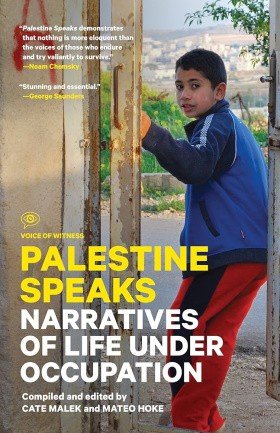—June: Three Israeli teens are kidnapped near Hebron. Though Israeli officials have strong evidence that the teens have been killed shortly after the kidnapping, raids and mass arrests are undertaken throughout the West Bank. Israeli re-arrests dozens of Palestinians previously released as part of the Gilad Shalit prisoner swap. Weeks later, a Palestinian teen in East Jerusalem is kidnapped and murdered by Israeli settlers.
—July: Hamas begins firing rockets into Israel, claiming that the attacks are driven by the re-arrest of prisoners from the Gilad Shalit prisoner swap, as well as the continued siege of Gaza. The Israeli military launches what it calls Operation Protective Edge in the Gaza Strip. After a week of bombings, Israel sends a ground force into Gaza. In the first month of Operation Protective Edge, over 1,800 Gazans are killed, the majority civilians.
—August: Israeli strikes in Gaza continue. A unified Palestinian delegation negotiates a cease-fire with Israel through Egypt. Rockets from Gaza also continue. Through the end of August, over 2,100 Palestinians have been killed, while four Israeli civilians and over sixty Israeli soldiers have also been killed.
II. GLOSSARY
administrative detention: A legal procedure under which detainees are held without charges or trial. Some forms of administrative detention are legal under international law during times of war and while peace agreements are negotiated between opposing factions. Many of the detainees in Guantanamo Bay, Cuba, are held by the United States in administrative detention indefinitely, and the procedure has also been employed in Northern Ireland against the Irish Republican Army and in South Africa during the apartheid era. Administrative detention was employed by the British against Jewish insurgents during the British Mandate of Palestine, and the Israeli military adopted the practice at the formation of Israel. In 2014, Israel has held as many as 300 Palestinians in administrative detention. Though each term of detention is limited to a set number of days (usually a single day to as many as six months), detention can be renewed in court, meaning detainees can be held indefinitely without trial or charges. Though article 78 of the Fourth Geneva Convention grants occupying powers the right to detain persons in occupied territories for security reasons, it stipulates that this procedure should only be used for “imperative security reasons” and not as punishment. During the Second Intifada, Israel arrested tens of thousands of males between the ages of fourteen and forty-five without charges.
Al-Aqsa Martyrs’ Brigades: The informal military wing of the Fatah party. Though some members of Fatah disavow the brigades, they have been actively associated with the party since the Second Intifada. The brigades are considered a terrorist organization by Israel, the United States, Europe, and others.
Al-Quds Brigades: The military wing of the Islamic Jihad in Palestine movement. The Al-Quds Brigades were especially active around the city of Jenin during the Second Intifada, but the strength of the organization has been diminished since the end of the Intifada.
Arab: A designation that is defined by broad cultural and linguistic ties rather than by ethnic, geographic, or religious affiliations. Most Arabs speak some version of Arabic, of which there are numerous dialects. Approximately 80 to 90 percent of Arabs identify themselves as Muslim. Most of the rest are Christian. There is some disagreement over whether or not Jews living in Palestine before the Zionist movement were considered Arab or not, even those who spoke Arabic.
Arab-Israeli War: A conflict between newly formed Israel and neighboring Arab nations that has shaped Israeli–Palestinian relations since 1948. Tensions between Jewish and Arabic residents of the British Mandate in Palestine (1923–1948) were high leading up to the 1947 United Nations announcement of partition of the region into a Jewish nation (Israel) and a state for the region’s non-Jewish Arab population (Palestine). The Arab League, an organization of neighboring Arab countries, opposed the partition plan, and declared war on Israel in May of 1948, immediately after Israel officially declared statehood. The war between the Arab States and Israel lasted until armistice agreements in the spring of 1949. During the war, more than 750,000 Palestinians were displaced from their homes, and Israel annexed 60 percent of the land that had been demarcated as Palestinian territory under the 1947 U.N. partition plan. Palestinians refer to the war and its aftermath as the Nakba, or “catastrophe,” and much of Palestinian politics today is driven by the claimed right of families to return to lands they were expelled from in 1948.
Arab League: An organization of Arab countries that was formed in 1945. It originally included Egypt, Iraq, Jordan, Lebanon, Saudi Arabia, and Syria. The Arab League has grown to include twenty-two countries and is chartered to promote Arab economic and political interests. During the Arab-Israeli War in 1948, the Arab League countries launched a joint attack on newly formed Israel in response to the displacement of Arabs within Israel’s newly declared borders.
Areas A, B, and C: Administrative areas within the West Bank that were established following the 1993 Oslo Accords. In Area A, the Palestinian Authority maintains full civil and security control. This area makes up only 18 percent of the West Bank but includes dense urban areas—the cities of Bethlehem, Hebron (approximately 80 percent of the city), Jenin, Jericho, Nablus, Qalqilya, Ramallah, and Tulkarm. Israeli citizens are forbidden to enter territory designated Area A; however, the Israeli Defense Forces conduct raids and arrests in these territories. In practice, few Israeli citizens have trouble when entering Area A territories. Area B represents 22 percent of West Bank territory and is mapped out around approximately 440 Palestinian villages. Here, the Palestinian Authority maintains civil control while Israel maintains security control. Area B territories are not supposed to have any Israeli settlements, though Israeli citizens are permitted to travel throughout Area B under certain circumstances, such as to visit religious sites. In Area C, Israel maintains full civil and security authority. Area C represents 60 percent of West Bank land area and is the home to as many as 500,000 Israeli settlers. Palestinians are partially restricted from entering Area C. However, approximately 200,000–300,000 Palestinians, including Bedouins and some farmers, live in Area C, though their access to resources such as water and electricity is significantly restricted.
Balfour Declaration: A diplomatic letter publicly released by the British government on November 2, 1917, that declared support for a Jewish nation following the dissolution of the Ottoman Empire in return for Jewish support during World War I. The Balfour Declaration conflicted with a promise made through T. E. Lawrence for support of a pan-Arab nation in the same territory.
Bedouin: An ethnic group with historical ties to the Arabian Peninsula. The Bedouin were traditionally nomadic, desert-dwelling, tribal peoples who spoke Arabic. Today, approximately 40,000 Bedouin live in Palestine, many in Area C of the West Bank.
Black September: The name for a civil war fought in Jordan beginning in September in 1970 and ending in July 1971. The war was waged between the Palestinian Liberation Organization and the Jordanian monarchy. Since the Arab-Israeli War of 1948, the population of Jordan (which included the West Bank) was around two-thirds Palestinian, making Palestinians the dominant force in Jordanian politics. The war led to the end of citizenship in Jordan for Palestinian refugees and forced the base of the Palestinian resistance movement to southern Lebanon.
British Mandate for Palestine: Following the breakup of the Ottoman Empire and the end of World War I, Great Britain assumed administrative control of former Ottoman-ruled territories east of the Jordan River (Transjordan, now the Kingdom of Jordan) and west of the Jordan River (Palestine). Formal British control began in 1923 and was set to expire in 1948 with the formation of independent states, including a national home for the Jewish people and a state for the Mandate’s Arab population as well.
checkpoints: Barriers on transportation routes maintained by the Israeli Defense Forces on transportation routes within the West Bank. The stated purpose of the checkpoints in the West Bank is to protect Israeli settlers, search for contraband such as weapons, and prevent Palestinians from entering restricted areas without permits. The number of fixed checkpoints varies from year to year, but there may be as many as one hundred throughout the West Bank. In addition, there are temporary roadblocks and surprise checkpoints throughout the West Bank that may number in the hundreds every month. For Palestinians, these fixed and temporary checkpoints—where they may be detained, delayed, or questioned for unpredictable periods of time—make daily planning difficult and can make cities or villages only a few miles away seem like distant points on the map.
crossing points: Crossing points are the gateways into Israel from parts of Palestine, or between Palestine and neighboring countries such as Egypt and Jordan. There are currently five crossing points by land into the Gaza Strip, and most of them have been closed or significantly restricted since the Israeli military blockade was imposed in 2007. There are seventy-three barrier-gate crossing points from West Bank into Israel, and Palestinians with permits have access to thirty-eight of them.
Dome of the Rock: The Dome of the Rock and the Al-Aqsa Mosque (“the farthest mosque”) are built on the Temple Mount, considered one of the holiest sites in Judaism. They mark the location where Muslims believe Prophet Muhammad was miraculously transported from Mecca to Jerusalem in a single night to lead other prophets in prayer and also receive instructions from God regarding the rituals of prayer. The site remains a focal point of conflict in Israeli–Palestinian negotiations.
East Jerusalem: The eastern districts of the city of Jerusalem are among the major flashpoints in the Israeli–Palestinian relationship. Both Israel and Palestine have declared Jerusalem to be their respective capitals, and the area is home to some of the holiest sites in Judaism and Islam—the Temple Mount and the Al-Aqsa Mosque and Dome of the Rock. Following the Arab-Israeli War, Israel claimed the western half of the city (which was mostly Jewish) while Jordan claimed the eastern half (which was mostly Muslim and Christian Arab). Israel occupied all of Jerusalem following the Six-Day War in 1967. Israel subsequently annexed an area including East Jerusalem itself and a twenty-five-square-mile territory surrounding it that had formerly been administered by Jordan. Arabs living in East Jerusalem following the Six-Day War were granted permanent resident status in Israel and permitted to apply for Israeli citizenship, though few chose to do so. East Jerusalem was made up of over 60,000 Arabs and just a few hundred Jewish residents in 1967, but by the time the Oslo Accords were negotiated in 1993, Israelis outnumbered Arabs in East Jerusalem by about 155,000 to 150,000.
Fatah: A left-leaning political party that makes up the majority of the Palestinian Liberation Organization coalition. Fatah was founded in 1959 largely by Palestinian refugees who had been displaced by the 1948 Arab-Israeli war. After its founding, Fatah had several militant wings and conducted a number of military actions against Israel, and Israel targeted military and non-military elements of Fatah.
Gaza Blockade: An Israeli military blockade of goods coming into and out of the Gaza Strip by air, land, and sea, which has been imposed since 2007, the year that the political party Hamas seized full control of the Gaza Strip. Israel (as well as the United States, the European Union, Jordan, Egypt, and others) considers Hamas a terrorist organization.
Gaza Strip: A 140-square-mile territory between Egypt, Israel, and the Mediterranean Sea that is currently independently governed by the political party Hamas. Gaza shares a thirty-two-mile-long border with Israel that is sealed off by the Israeli–Gaza barrier. Gaza has been self-governing since 2005, when Israeli military forces withdrew and Israeli settlements were removed. In 2005, Gaza was administered by the Palestinian Authority. In 2006, the political party Hamas won control of the parliament of Gaza in democratic elections, and then severed its relationship with the Palestinian Authority after violent confrontations with members of the party Fatah, which makes up the bulk of the Palestinian Authority. Following the victory by Hamas, Israel imposed a blockade on Gaza, officially to ensure that weapons such as rockets did not fall into the hands of Hamas, which it considers a terrorist organization. In 2012, the United Nations recognized Gaza as part of the state of Palestine, though Hamas and the Palestinian Authority have never fully reconciled, and the Palestinian Authority has no control in Gaza. Gaza is home to over 1.7 million Palestinians, and the vast majority (75 percent) are considered refugees by the United Nations.
Geneva Accord: A peace initiative that took place in Geneva, Switzerland, in 2003, during the middle of the Second Intifada. Israeli and Palestinian representatives agreed on the outlined details regarding borders of two separate states (a two-state solution), compensation for refugees, and land-swap deals for the removal of settlements. The plan was refined and expanded in 2009 and remains the most detailed proposal of a two-state solution to be tentatively agreed upon by many Israeli and Palestinian officials.
Golan Heights: An area along Israel’s border with Syria and Lebanon that Israel annexed from Syria in 1981. The region is important as a strategic military position as well as a source of fresh water.
Green Line: The lines of demarcation agreed upon between Israel and its neighbors during the armistice after the Arab-Israeli War, also known as the 1949 Armistice Line or the “pre-1967 borders.” The armistice line is the basis of negotiations for a two-state solution in most major peace initiatives between Israel and Palestine, with some land swaps included. After the Six-Day War in 1967, Israel occupied territory beyond the Green Line, including the West Bank, Gaza, Golan Heights, and the Sinai Peninsula.
Gush Emunim: An activist movement founded in 1974 within Israel that sought the fulfillment of Biblical prophecy through the settlement of the lands known in the Bible as Judea and Samaria and today known as the West Bank. Starting in the late seventies, Gush Emunim led numerous settlement groups to establish a presence in the West Bank, sometimes with the cooperation of the Israeli government and sometimes despite legal sanctions imposed by the government.
Hamas: A political party founded in 1987 as an offshoot of the Egyptian Muslim Brotherhood. Hamas is a Sunni Islamist political party, and its stated aims are to liberate Palestine from Israel and establish an Islamic state in the region that now encompasses Israel and the occupied territories. Hamas gained greater influence in the early 2000s, surging to power on dissatisfaction with the Palestinian Authority, which many Palestinians viewed as corrupt and willing to cede too much to Israel in peace negotiations. After winning parliamentary elections in the Gaza Strip in 2006, Hamas solidified its power in Gaza after violent skirmishes with opposition party Fatah. By 2007, Hamas had effectively taken control of Gaza, driving the Palestinian Authority from power there. Because Israel views Hamas as a terrorist organization, it imposed a crippling economic blockade on the Gaza Strip following Hamas takeover. In the spring of 2014, Hamas and Fatah announced a political reconciliation, though to date Hamas remains the sole power in Gaza.
International Red Cross and Red Crescent Movement: A group of international humanitarian organizations founded in 1863 with the purpose of assisting victims of disasters and providing developmental aid to strengthen communities in crisis. The movement is made up of three distinct organizations: the International Committee of the Red Cross (ICRC), which safeguards human rights in conflict zones; the International Federation of the Red Cross and Red Crescent (IFRC) which coordinates relief assistance missions around the globe; and National Red Cross and Red Crescent Societies, which address humanitarian needs and are organized on the national level. The Palestine Red Crescent Society is one of the National Red Cross and Red Crescent Societies. It was formed in 1968 and has over 4,000 employees and 20,000 volunteers. Because the Palestinian Authority administers only a patchwork of territory within the West Bank, the Palestine Red Crescent Society provides some essential services to Palestinian citizens, including ambulance service and some medical care.
Intifada:Intifada in Arabic means “to shake off,” and the term is popularly used throughout the Arab world to mean a rebellion or act of resistance. In Palestine, Intifada usually refers to two intense periods of conflict. The First Intifada began in 1987, after increasing tensions between Palestine and Israel, including a number of civilian deaths. It included years of civil disobedience against the Israeli occupation, as well as armed attacks that led to the deaths of nearly 200 Israelis and over 1,000 Palestinians. The First Intifada began to wind down with the signing of the Oslo Peace Accords in 1993. The Second Intifada began in September of 2000, after a conflict between Palestinian protesters and the Israeli Defense Forces led to deaths. In the ensuing violence from 2000 to 2005, approximately 1,000 Israelis and 3,000 Palestinians were killed.
Israel: A state founded in 1948 to be a national home of the Jewish people. Today, Israel has a population of over 8 million, with slightly over 75 percent of the population Jewish and slightly over 20 percent Arab. Its capital is Jerusalem. Hebrew and Arabic are both official languages.
Israeli Defense Forces (IDF): The Israeli Defense Forces were established with the formation of Israel in 1948, and were formed from the paramilitary group the Haganah. Today, there are over 175,000 active personnel and 450,000 reserves in the IDF. Military service starting at age eighteen is compulsory for most Israeli citizens. In practice, only about half of all eighteen-year-old Israelis end up enlisting in active duty. Israel’s Arab population, which makes up 20 percent of the total population of the country, is exempt, but Arabs may serve if they wish. A number of other exemptions exist, though they change from year to year. They include physical or mental disability, religious studies, demonstrated moral objections such as a commitment to pacifism, and enrollment in alternative national civil service programs.
Israel–Gaza barrier: A wall between Israel and the Gaza Strip constructed in 1994 following the Oslo Peace Accords. Much of it was destroyed during the Second Intifada, but it has since been rebuilt. An additional wall between Gaza and Egypt was built in 2005. The barrier has only five crossing points. The Erez crossing is a pedestrian and cargo crossing into Israel at the north end of the strip, a couple of miles north of Gaza City. Since the military blockade of Gaza was put in place in 2007, Gazans must obtain permits to pass through the crossing, which are usually only granted for medical or humanitarian reasons. The Karni crossing, just southeast of Gaza City, is a cargo crossing that has been completely sealed since the start of the military blockade. The Rafah crossing is Gaza’s main crossing into Egypt. It was closed by Egypt following Hamas’s expulsion of Fatah in 2007, and it has been opened and closed numerous times since. The Kerem Shalom and Sufa crossings are smaller cargo crossings in southern Gaza, near the city of Rafah, and are used mostly for transportation of humanitarian assistance into Gaza.
Israeli–West Bank barrier: A wall between Israel and the West Bank that was built starting in 2002. When completed, it will be approximately 440 miles long. The wall deviates from the 1949 Armistice Line (the “Green Line”) that has come to define the boundary between Israel and the West Bank. The 440-mile barrier will leave slightly more than 10 percent of Green Line-defined West Bank on the Israeli side of the wall. This land, known in Israel as the “seam zone,” is home to many of the Israeli settlers in the West Bank and also as many as 275,000 Palestinians.
Nakba: Means “catastrophe” in Arabic. Commonly used by Palestinians and other Arabs to refer to the displacement of Arabs before, during, and after the 1948 Arab-Israeli War. The conflict displaced more than 750,000 Palestinians between 1947 and 1950. Many Palestinian families fled to Egypt, Jordan, or elsewhere outside the lands claimed by Israel in the aftermath of the war. The Nakba still drives Palestinian politics, with generations of refugees continuing to claim a right of return to properties owned before 1948 that are now part of Israel.
one-state solution: A proposed peace plan that would make all of Israel and Palestine a single state, with equal voting and legal protections for all citizens. Though increasingly popular among Palestinian Arabs as the best possible result of the peace process, the one-state solution is opposed by the majority of Israelis because they would become a demographic minority in a unified state. Current peace process negotiations continue to target a two-state solution.
Operation Cast Lead: A three-week-long invasion of the Gaza Strip by the Israeli Defense Forces between December of 2008 and January of 2009. The stated reason for the invasion was to stop rocket attacks from Gaza and weapons smuggling into Gaza. During the invasion, Israeli jets bombed numerous military and administrative facilities in Gaza, including those in densely populated areas of Gaza City and Rafah. More than 1,400 Palestinians were killed in the invasion.
Operation Defensive Shield: A large-scale military operation by the Israeli Defense Forces within the West Bank in 2002, during the height of the Second Intifada. The stated goal of the operation was to arrest or kill Palestinian militants in the region and halt rocket attacks and suicide bombings in Israel. During a period of a little over a month, the Israeli Defense Forces entered West Bank cities and laid siege to the compound of Yasser Arafat and the Palestinian Authority in Ramallah. Around 250 Palestinians were killed, while 30 Israeli soldiers were killed. The operation represented the most significant military incursion into the West Bank since the Six-Day War in 1967.
Operation Pillar of Defense: An Israeli military invasion of the Gaza Strip that lasted eight days, starting on November 14, 2012. The stated goal of the invasion was to stop rocket attacks and disrupt military networks. The Israeli Defense Forces struck over 1,500 targets during the invasion. As many as 167 Palestinians were killed. During the operation, Palestinian rockets launched into Israel killed six Israeli civilians.
Oslo Accords: A series of negotiated agreements between the leadership of Israel and the Palestine Liberation Organization starting in 1993, during the height of the First Intifada. The goal of the accords was to institute a peace plan and create an interim Palestinian government in anticipation of eventual Palestinian statehood. The Oslo Accords led to the creation of the Palestinian National Authority (subsequently called the Palestinian Authority), a temporary governing body formed from the administration of the PLO.
Palestine: The name Palestine is derived from a term used in Ancient Egypt for the region bordering the Egyptian empire along the eastern coast of the Mediterranean. Today, Palestine may refer to the entire region made up of Israel, occupied territories, and territory under control of the Palestinian people, or it may refer to the areas of the West Bank and Gaza, defined as Palestine under the 1949 Armistice Agreement. It can also refer to the limited areas administered completely by the Palestinian people, which make up all of the Gaza Strip and approximately 18 percent of the West Bank. The Palestinian population living in Palestine and abroad is hard to determine but probably numbers around 10 million in 2014. Though the Palestinian Authority claims Jerusalem as its capital, its de facto administrative capital is Ramallah.

























